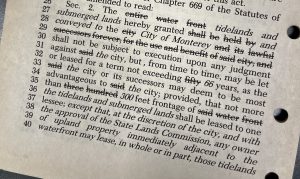
Clients have asked us how to use our legislative history materials in cases where an earlier bill enacts a particular word or phrase but then a subsequent bill makes changes to the statute omitting the earlier phrase. In other words, what did the Legislature intend when it omitted the earlier enacted language?
Short of finding specific discussion in the legislative history research material as to why the language was left out, case law can be useful in understanding legislative intent. While Legislative Intent Service, Inc. provides an objective service summarizing the historical material provided, an added help to clients can be researching case law to decipher certain legislative actions. For example, a quick search in a legal research database reveals statements from the bench such as the following:
- “Generally, the most reliable indicator of legislative intent is the words of the statute.” (Even Zohar, supra, 61 Cal.4th at pp. 837–838, 189 Cal.Rptr.3d 824, 352 P.3d 391.) (Tan v. Superior Ct. of San Mateo Cnty., 76 Cal. App. 5th 130, 136, 291 Cal. Rptr. 3d 292, 296 (2022), review denied (May 18, 2022))
- “The interpretation of a statute is a question of law we review independently.” (In re Lana S. (2012) 207 Cal.App.4th 94, 108, 142 Cal.Rptr.3d 792.) To ascertain legislative intent, we first examine the words of the statute and, if the statutory language is clear and unambiguous, its plain meaning governs. (In re Joshua A. (2015) 239 Cal.App.4th 208, 214, 190 Cal.Rptr.3d 655.) A court may not interpret a statute to reflect an intention that does not appear from its plain language (In re Y.A. (2016) 246 Cal.App.4th 523, 527, 200 Cal.Rptr.3d 933), and when a particular word or phrase is used in a particular statutory scheme, the omission of similar language from a related provision is often evidence of a different legislative intent. (In re Joshua A., at p. 215, 190 Cal.Rptr.3d 655.) (Adoption of A.B., 2 Cal. App. 5th 912, 919, 206 Cal. Rptr. 3d 531, 537 (2016))
- … language may not be inserted into a statute that the Legislature has omitted. (Conrad v. Medical Bd. of California (1996) 48 Cal.App.4th 1038, 1046, 55 Cal.Rptr.2d 901; Khan v. Medical Board (1993) 12 Cal.App.4th 1834, 1845, 16 Cal.Rptr.2d 385 (Khan ) [“The Legislature’s failure to include ‘knowingly’ or ‘intentionally’ or other qualifying words signals that it did not intend either guilty knowledge or intent to be elements of” the licensing statute at issue.].) (Sternberg v. California State Bd. of Pharmacy, 239 Cal. App. 4th 1159, 1168, 191 Cal. Rptr. 3d 691, 698 (2015))
We have a handy document on our website, https://www.legintent.com/state-legislative-points-and-authorities, that attorneys may find useful to reference, “Using Extrinsic Aids in Statutory Construction”. This guide is organized by type of legislative history document and provides case law annotations referencing the various documents and the weight given each type of document by the courts (i.e., enrolled bill reports, committee analyses, letters to the Governor by the bill’s author, etc.). Our website also contains various other research aids that may prove useful to our client in interpreting their research material.
For over 40 years, Legislative Intent Service, Inc. has been providing the legislative history for bills and propositions from the 1800s to the present. If you are interested in knowing more about the background of any statute in any of the 50 states or federal statutes, please contact our office today! We even provide a legislative history report and analysis on your bill of interest with a procedural summary that helps guide you through the intricacies of how your bill eventually became law. Please contact our office for a quote today: quote@legintent.com or (530) 666-1917.
